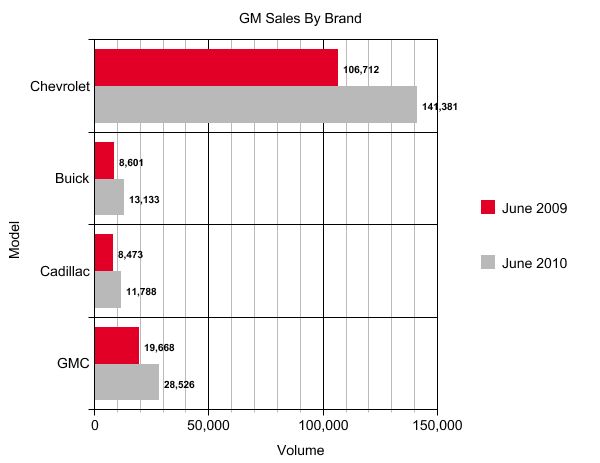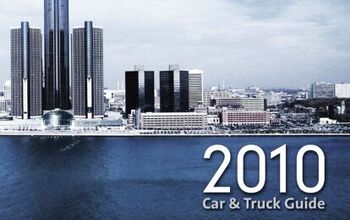GM "Core Brand" Sales Up 36 Percent In June On Strong Fleet Sales
Sales of GM’s four “core brands” were up 36 percent last month [release here], however that number is compared to June 2009 sales, when GM was in bankruptcy. Even against this backdrop, however, GM’s sales show some signs of continued weakness. Though Chevrolet gained 32 percent in overall, its retail sales improved a mere 11 percent, meaning a huge number of Chevy’s sales went to fleets. Out of Buick’s 53 percent volume gain, retail sales increased only 28 percent. Cadillac had much less of a fleet problem than Buick and Chevy, increasing sales 339 percent and retail sales 35 percent. GMC did not release retail numbers for GMC, but noted that GM’s overall fleet sales were 59,571 for the month. That means nearly one in three vehicles sold by GM last month went to a fleet, a percentage that accounts for the lion’s share of GM’s sales growth. Once again, Detroit seems addicted to fleet sales…
Of course, GM’s new products helped with the 11 percent retail sales gain. LaCrosse stayed over 5k units last month, for a 173 percent increase over last June. SRX saw a 461 percent increase to 3,804 units, while its Equinox cousin added another 180 percent to 11,490 units. GMC’s Terrain also sold 4,603 units. Traverse added 56 percent to 11,371 units.
But, as is always the case, new products eventually lose their luster, and several of GM’s once hot-selling products are slackening off. Camaro is down nearly 20 percent from its high last June, moving 7,540 units. Enclave and Acadia eased up on their sales growth, adding only 20 and 26 percent respectively over last June’s weak numbers. Sierra saw a similarly stagnant June, improving just 27 percent to 11,441 units. The aging Impala and HHR both suffered 3 percent sales drops, despite likely sending a fair number of units to GM’s booming fleet business.
GM’s hot products continue to drive growth, with heartening signs coming from Buick (staying strong with the LaCrosse) and Cadillac (which benefitted from improved CTS (+31%) and strong SRX sales). Chevy, meanwhile, is likely seeing strong retail growth for its Equinox and Traverse, but it’s dead in the water on the sedan front, with only the Malibu likely making retail progress. With the launch of the Cruze looming, GM had better hope the response is strong, otherwise GM seems destined to grow only as a supplier to fleets. And as The General (and Detroit a large) has already learned, that short term growth always comes at the expense of long-term resale and brand equity.
The numbers are up, but there’s still much work to be done.
More by Edward Niedermeyer
Latest Car Reviews
Read moreLatest Product Reviews
Read moreRecent Comments
- Kjhkjlhkjhkljh kljhjkhjklhkjh A prelude is a bad idea. There is already Acura with all the weird sport trims. This will not make back it's R&D money.
- Analoggrotto I don't see a red car here, how blazing stupid are you people?
- Redapple2 Love the wheels
- Redapple2 Good luck to them. They used to make great cars. 510. 240Z, Sentra SE-R. Maxima. Frontier.
- Joe65688619 Under Ghosn they went through the same short-term bottom-line thinking that GM did in the 80s/90s, and they have not recovered say, to their heyday in the 50s and 60s in terms of market share and innovation. Poor design decisions (a CVT in their front-wheel drive "4-Door Sports Car", model overlap in a poorly performing segment (they never needed the Altima AND the Maxima...what they needed was one vehicle with different drivetrain, including hybrid, to compete with the Accord/Camry, and decontenting their vehicles: My 2012 QX56 (I know, not a Nissan, but the same holds for the Armada) had power rear windows in the cargo area that could vent, a glass hatch on the back door that could be opened separate from the whole liftgate (in such a tall vehicle, kinda essential if you have it in a garage and want to load the trunk without having to open the garage door to make room for the lift gate), a nice driver's side folding armrest, and a few other quality-of-life details absent from my 2018 QX80. In a competitive market this attention to detai is can be the differentiator that sell cars. Now they are caught in the middle of the market, competing more with Hyundai and Kia and selling discounted vehicles near the same price points, but losing money on them. They invested also invested a lot in niche platforms. The Leaf was one of the first full EVs, but never really evolved. They misjudged the market - luxury EVs are selling, small budget models not so much. Variable compression engines offering little in terms of real-world power or tech, let a lot of complexity that is leading to higher failure rates. Aside from the Z and GT-R (low volume models), not much forced induction (whether your a fan or not, look at what Honda did with the CR-V and Acura RDX - same chassis, slap a turbo on it, make it nicer inside, and now you can sell it as a semi-premium brand with higher markup). That said, I do believe they retain the technical and engineering capability to do far better. About time management realized they need to make smarter investments and understand their markets better.


































Comments
Join the conversation
Perhaps GM/Ford/Chrylser could produce fleet only models badged as the Hertz Supreme, Thrifty Runabout, etc. in the same way name brand food companies make store brands for grocery stores. They could obscure the similarity to the retail version by altering panels, color schemes and tail lights. If they do this on the cheap, it may be a cost effective way to protect their main retail brands. Other posters here on TTAC have described the interesting ways that US models were uniquely altered for the Canadian market (for retail sales). Eventually, Chinese made cars will probably become the main suppliers for the rental car business. Those agencies will probably want to conceal that fact by using house brands that sound either really anglo or Italian . While car enthusiasts will know the true origin, most consumers will have limited awareness.
I just got home to Nashville from a business trip to Tulsa. This morning I walked through the rental lots at Tulsa airport and the predominate cars were Impalas and Chargers with a whole lot of Camrys too. That is where a lot of sales are going these days.